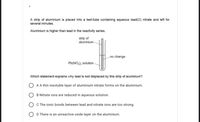
Chemistry
10th Edition
ISBN: 9781305957404
Author: Steven S. Zumdahl, Susan A. Zumdahl, Donald J. DeCoste
Publisher: Cengage Learning
expand_more
expand_more
format_list_bulleted
Question

Transcribed Image Text:A strip of aluminium is placed into a test-tube containing aqueous lead(II) nitrate and left for
several minutes.
Aluminium is higher than lead in the reactivity series.
strip of
aluminium
-no change
Pb(NO,), solution
Which statement explains why lead is not displaced by this strip of aluminium?
A A thin insoluble layer of aluminium nitrate forms on the aluminium.
B Nitrate ions are reduced in aqueous solution.
C The ionic bonds between lead and nitrate ions are too strong.
D There is an unreactive oxide layer on the aluminium.
Expert Solution
This question has been solved!
Explore an expertly crafted, step-by-step solution for a thorough understanding of key concepts.
This is a popular solution
Trending nowThis is a popular solution!
Step by stepSolved in 2 steps

Knowledge Booster
Learn more about
Need a deep-dive on the concept behind this application? Look no further. Learn more about this topic, chemistry and related others by exploring similar questions and additional content below.Similar questions
- The reaction Nickel chloride + Sodium carbonate is an example of which of the following types of reaction? (Acids, bases, and salts that are soluble in water are present as aqueous solutions.) Select one: A. Solution + Solution = Gas + Soluble salt B. Insoluble salt + Solution = Gas + Soluble salt C. No reaction occurs. D. Solution + Solution = Precipitate + Soluble saltarrow_forwardBalanced net ionic equation: 3) Get two medium test tubes. Into one, place about 2 mL of a solution of hydrochloric acid. Into the other add a small amount of solid sodium carbonate. Note the appearances of the contents in the two test tubes and then mix them together noting any changes that have taken place. Change(s) that took place when the test tube contents were mixed: Balanced chemical equation: Balanced ionic equation: Balanced net ionic equation:arrow_forward4) Magnesium metal is dropped into a solution of zinc nitrate. Balanced Equation: Total Ionic Equation: Net Ionic Equation:5) Calcium metal is dropped into water. The products are calcium hydroxide and hydrogen gas. Balanced Equation: Total Ionic Equation: Net Ionic Equation:6) Solutions of aluminum sulfate and calcium acetate react in a double replacement reaction. Balanced Equation: Total Ionic Equation: Net Ionic Equation:arrow_forward
arrow_back_ios
arrow_forward_ios
Recommended textbooks for you
 ChemistryChemistryISBN:9781305957404Author:Steven S. Zumdahl, Susan A. Zumdahl, Donald J. DeCostePublisher:Cengage Learning
ChemistryChemistryISBN:9781305957404Author:Steven S. Zumdahl, Susan A. Zumdahl, Donald J. DeCostePublisher:Cengage Learning ChemistryChemistryISBN:9781259911156Author:Raymond Chang Dr., Jason Overby ProfessorPublisher:McGraw-Hill Education
ChemistryChemistryISBN:9781259911156Author:Raymond Chang Dr., Jason Overby ProfessorPublisher:McGraw-Hill Education Principles of Instrumental AnalysisChemistryISBN:9781305577213Author:Douglas A. Skoog, F. James Holler, Stanley R. CrouchPublisher:Cengage Learning
Principles of Instrumental AnalysisChemistryISBN:9781305577213Author:Douglas A. Skoog, F. James Holler, Stanley R. CrouchPublisher:Cengage Learning Organic ChemistryChemistryISBN:9780078021558Author:Janice Gorzynski Smith Dr.Publisher:McGraw-Hill Education
Organic ChemistryChemistryISBN:9780078021558Author:Janice Gorzynski Smith Dr.Publisher:McGraw-Hill Education Chemistry: Principles and ReactionsChemistryISBN:9781305079373Author:William L. Masterton, Cecile N. HurleyPublisher:Cengage Learning
Chemistry: Principles and ReactionsChemistryISBN:9781305079373Author:William L. Masterton, Cecile N. HurleyPublisher:Cengage Learning Elementary Principles of Chemical Processes, Bind...ChemistryISBN:9781118431221Author:Richard M. Felder, Ronald W. Rousseau, Lisa G. BullardPublisher:WILEY
Elementary Principles of Chemical Processes, Bind...ChemistryISBN:9781118431221Author:Richard M. Felder, Ronald W. Rousseau, Lisa G. BullardPublisher:WILEY

Chemistry
Chemistry
ISBN:9781305957404
Author:Steven S. Zumdahl, Susan A. Zumdahl, Donald J. DeCoste
Publisher:Cengage Learning

Chemistry
Chemistry
ISBN:9781259911156
Author:Raymond Chang Dr., Jason Overby Professor
Publisher:McGraw-Hill Education

Principles of Instrumental Analysis
Chemistry
ISBN:9781305577213
Author:Douglas A. Skoog, F. James Holler, Stanley R. Crouch
Publisher:Cengage Learning

Organic Chemistry
Chemistry
ISBN:9780078021558
Author:Janice Gorzynski Smith Dr.
Publisher:McGraw-Hill Education

Chemistry: Principles and Reactions
Chemistry
ISBN:9781305079373
Author:William L. Masterton, Cecile N. Hurley
Publisher:Cengage Learning

Elementary Principles of Chemical Processes, Bind...
Chemistry
ISBN:9781118431221
Author:Richard M. Felder, Ronald W. Rousseau, Lisa G. Bullard
Publisher:WILEY